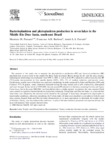Use este identificador para citar ou linkar para este item:
http://www.alice.cnptia.embrapa.br/alice/handle/doc/1009158Registro completo de metadados
| Campo DC | Valor | Idioma |
|---|---|---|
| dc.contributor.author | PETRUCIO, M. M. | pt_BR |
| dc.contributor.author | BARBOSA, F. A. R. | pt_BR |
| dc.contributor.author | FURTADO, A. L. dos S. | pt_BR |
| dc.date.accessioned | 2015-02-20T11:11:11Z | pt_BR |
| dc.date.available | 2015-02-20T11:11:11Z | pt_BR |
| dc.date.created | 2015-02-20 | pt_BR |
| dc.date.issued | 2006 | pt_BR |
| dc.identifier.citation | Limnologica, v. 36, p. 192-203, 2006. | pt_BR |
| dc.identifier.uri | http://www.alice.cnptia.embrapa.br/alice/handle/doc/1009158 | pt_BR |
| dc.description | The purpose of this study was to measure the phytoplankton production (PP) and bacterial production (BP) simultaneously in seven lakes in the middle Rio Doce basin (southeast Brazil) during the dry and the rainy seasons. Limnological monitoring was conducted from 1999 to 2001 as well as both PP (radioactive carbon fixation) and BP (3H-Leucine incorporation) in four specific depths (100%, 10%, 1% of incident radiation, and aphotic zone). Furthermore, trophic state of the lakes was analyzed, considering the index proposed by Salas and Martino (1991) and Carlson (1977). In general, some parameters increased during the rainy season such as pH, conductivity, chlorophyll and total nitrogen. In the period of 1999/2000, the rain caused PP reduction in the lakes, excepting Carioca and Aguas Claras Lake, but in the years 2000/2001, the lakes did not show a similar pattern. In contrast, the rainy season of both years caused an expressive bacterioplankton production enhancing. Using Salas and Martino index, we observed that some lakes were affected by the seasonal runoff, therefore the typologie of these lakes changed from oligotrophic to mesotrophic conditions, otherwise considering the Carlson index all lakes were classified as eutrophic in both dry and rainy seasons. Indeed, Salas and Martino index demonstrated to be more appropriate to determine the trophic status of the lakes. Finally, our data indicate that until now, in spite of the lakes location, protected and unprotected area, the lakes still maintain their natural characteristics. | pt_BR |
| dc.language.iso | eng | eng |
| dc.rights | openAccess | eng |
| dc.subject | Trophic state | pt_BR |
| dc.subject | Bacterial secondary production | pt_BR |
| dc.subject | Primary production | pt_BR |
| dc.title | Bacterioplankton and phytoplankton production in seven lakes in the Middle Rio Doce basin, south-east Brazil. | pt_BR |
| dc.type | Artigo de periódico | pt_BR |
| dc.date.updated | 2015-02-20T11:11:11Z | pt_BR |
| dc.subject.nalthesaurus | Lakes | pt_BR |
| dc.subject.nalthesaurus | Phytoplankton | pt_BR |
| dc.subject.nalthesaurus | Bacterioplankton | pt_BR |
| riaa.ainfo.id | 1009158 | pt_BR |
| riaa.ainfo.lastupdate | 2015-02-20 | pt_BR |
| dc.identifier.doi | 10.1016/j.limno.2006.05.001 | pt_BR |
| dc.contributor.institution | MAURICIO M. PETRUCIO, UFSC; FRANCISCO A. R. BARBOSA, UFMG; ANDRE LUIZ DOS SANTOS FURTADO, CNPM. | pt_BR |
| Aparece nas coleções: | Artigo em periódico indexado (CNPM)  | |
Arquivos associados a este item:
| Arquivo | Descrição | Tamanho | Formato | |
|---|---|---|---|---|
| 4404.pdf | 487,12 kB | Adobe PDF |  Visualizar/Abrir |









